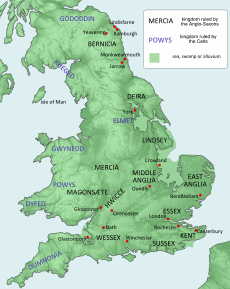Ecgric of East Anglia facts for kids
Quick facts for kids Ecgric |
|
|---|---|
| King of the East Angles | |
| Reign | c. 630 – c. 636 (jointly with Sigeberht until c. 634) |
| Predecessor | possibly Ricberht |
| Successor | Anna |
| Died | killed in battle c.630 |
| Dynasty | Wuffingas |
| Religion | Anglo-Saxon Paganism |
Ecgric (died around 636) was a king of East Anglia. This was an independent Anglo-Saxon kingdom in what is now eastern England. It included areas like Norfolk and Suffolk. Ecgric belonged to the Wuffingas royal family. This family ruled East Anglia for many years. We don't know exactly how he was related to other Wuffingas kings.
After the death of King Eorpwald around 627, East Anglia faced challenges. Ecgric's kinsman, Sigeberht, returned from exile. They ruled East Anglia together for a few years. Sigeberht worked to bring Christianity back to the kingdom. Ecgric might have remained a pagan, a person who followed older, non-Christian beliefs. Ecgric ruled alone after Sigeberht decided to retire to a monastery around 634. Both Ecgric and Sigeberht died in battle around 636. They were fighting against Penda, the king of Mercia. Ecgric was followed as king by Anna.
Contents
East Anglia's Place in History
In the early 600s, East Anglia was a powerful kingdom. King Rædwald was one of the strongest Anglo-Saxon rulers in the south. But after his time, Mercia grew stronger. East Anglia started to be influenced more by Mercia.
Rædwald's son, Eorpwald, became king. He was killed by a pagan noble around 627. After his death, East Anglia returned to pagan beliefs for three years. This period was a time of change for the region.
During this time, some members of the Wuffingas family made important marriages. These marriages helped to strengthen ties with Christian kingdoms. For example, Anna, who later became a Christian king, married a woman from the East Saxon area. His brother, Æthelric, married a princess from Northumbria. This marriage likely helped bring Christianity back to East Anglia.
Who Was Ecgric?
Ecgric was part of the Wuffingas royal family. But historians are not sure about his exact family tree. The main source of information is a book by the monk Bede. Bede called Ecgric Sigeberht's cognatus, which means 'kinsman'.
Some historians have suggested that Ecgric might be the same person as Æthelric. Æthelric was the son of Eni, Rædwald's brother. Æthelric's son, Ealdwulf, later became king of East Anglia. After Ecgric died, three other sons of Eni ruled the kingdom. This suggests that Rædwald's direct family line might have ended.
Ecgric/Æthelric placed as the son of Rædwald or the son of Eni
| Tytila | |||||||||||||||||||||||||||||||||||||||||||||||||||||||||||||||||||||
| ? | Rædwald | ? | Eni | ||||||||||||||||||||||||||||||||||||||||||||||||||||||||||||||||||
| Rægenhere | Eorpwald | Ecgric | Sigeberht | Ecgric | Anna | Æthelhere | Æthelwold | ||||||||||||||||||||||||||||||||||||||||||||||||||||||||||||||
Ruling Together
Sigeberht, who was Rædwald's son or stepson, became a Christian while in exile. He returned to East Anglia and brought back Christian rule. His time as king was busy. He worked to convert his people to Christianity. He also helped set up a bishopric, which is an area led by a bishop, for Felix of Burgundy. Sigeberht also started a school and supported a monastery.
For some time, Ecgric ruled East Anglia alongside Sigeberht. Bede's book, Historia Ecclesiastica Gentis Anglorum, tells us about this. It says that Sigeberht loved the idea of a heavenly kingdom so much that he gave up his crown. He gave it to his kinsman, Ecgric, who was already ruling part of the kingdom. Sigeberht then went to a monastery he had built. He became a monk, focusing on his religious life.
Having more than one ruler was sometimes common in Anglo-Saxon kingdoms. Ecgric and Sigeberht might have ruled different parts of East Anglia. These parts were later known as Norfolk and Suffolk. However, some historians think Ecgric might have been a sub-king. This means he ruled a smaller area under Sigeberht. He would have become the main king only after Sigeberht retired.
Unlike Sigeberht, Ecgric seems to have remained a pagan. There is no record that he was baptized. He also didn't seem to promote Christianity in East Anglia. Bede, who praised Sigeberht's Christian efforts, doesn't mention anything similar for Ecgric.
Ecgric's Time as Sole King
Around 633, Christian kingdoms faced difficulties. King Edwin of Northumbria was killed in battle. After this, the situation in Northumbria became stable again under King Oswald of Northumbria. East Anglia also benefited from Christian missions from Ireland.
Sigeberht was a supporter of these missions. He retired to his monastery around 634. This left Ecgric to rule East Anglia alone. So, Ecgric ruled a kingdom that was becoming more Christian. It was influenced by both Roman and Irish Christian traditions.
The Battle and Ecgric's Death
After Ecgric had ruled alone for about two years, Mercia attacked East Anglia. The Mercian army was led by King Penda. This battle likely happened around 636. Ecgric was warned about the attack. He was able to gather a large army.
The East Anglians knew that Mercia's army was very strong. They remembered Sigeberht as a brave leader. They asked him to lead them in battle, hoping his presence would inspire them. Sigeberht refused because of his religious life. But they carried him to the battlefield against his will. He refused to carry weapons and was killed. Ecgric was also killed during this battle. Many of his soldiers either died or ran away.
The exact place where this battle happened is not known. It was probably near the western border of East Anglia. Ecgric is one of the kings who might have been buried at Sutton Hoo. This famous site has a large ship burial. However, some historians think it's unlikely that Ecgric's Christian successor, Anna, would have given him a pagan ship burial.


